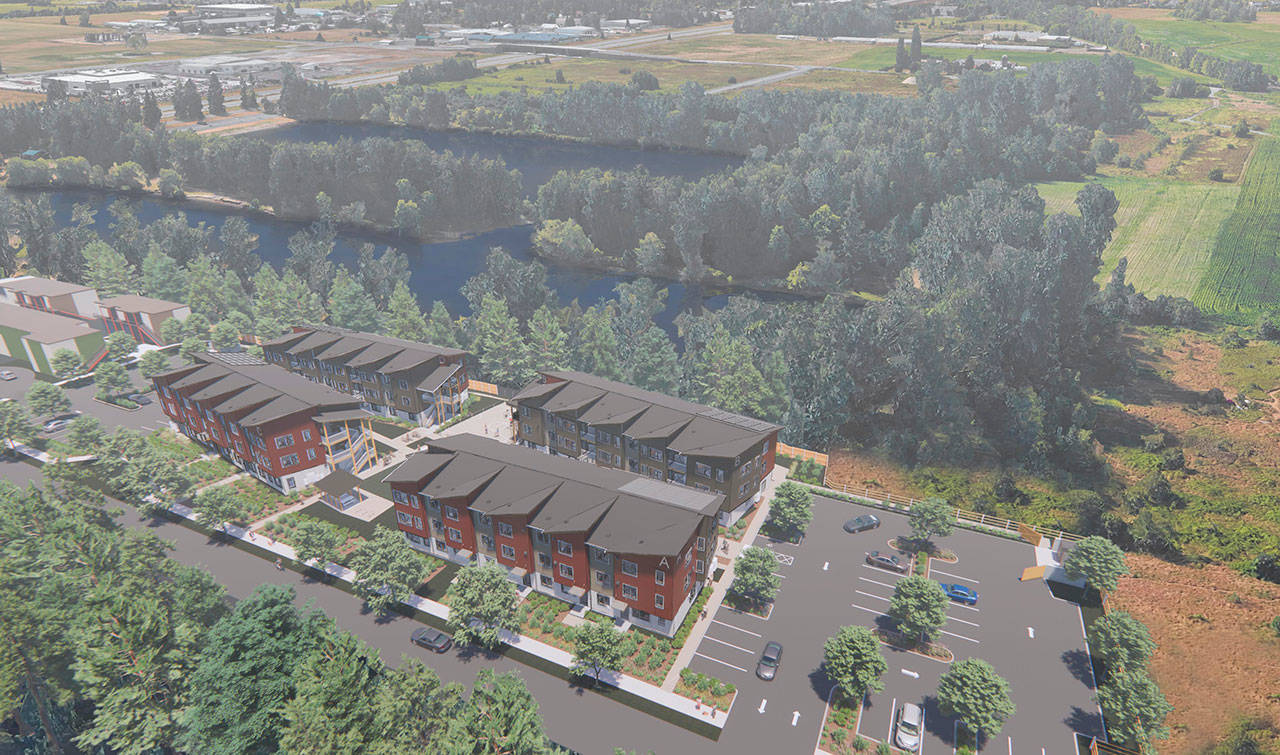By The Herald Editorial Board
One groundbreaking can look pretty similar to another as it marks the start of a construction project: There are public officials giving speeches, donning hard hats and grabbing shovels to toss some dirt.
It’s the stories of individuals, however, those who have been aided by similar projects, that make the case for attention to the start of such work.
Among the speakers Monday at the groundbreaking for Housing Hope’s latest project — Twin Lakes Landing II, with 60 units of two- and three-bedroom units of affordable housing for homeless and low-income families near Marysville’s Gissberg Twin Lakes — was Melonique “Mel” Simpson, a former Housing Hope resident, who now serves on the nonprofit’s board of directors.
Housing Hope, the leading provider of affordable housing and shelter for the homeless in Snohomish County, since 1987 has built 479 residential units and 301 homeowner residences. Much of that housing is paired with “wraparound” services — for education, training, jobs and family support — that are helping to break the cycle of poverty.
“I was a resident at Maple Leaf,” a Housing House development in Arlington, Simpson said. “I was a single mom during a dark phase of my life, and Housing Hope gave me and my family an opportunity to do better. They wrapped me up in those services and I was able to go to school and graduate from college.”
Simpson got her degree from the University of Washington and now owns her own home and her own business, and can now “give back what I got,” she said, as a member of Housing Hope’s board.
Twin Lakes Landing II, adjacent to the 50 units of housing at Housing Hope’s first Twin Lakes development, will provide 30 homes for homeless families and 30 homes for low-income families through a federal housing voucher program, administered by local housing authorities. The program assures they will pay no more than 30 percent of their income for rent.
With construction scheduled to begin next week, Twin Lakes Landing II is expected to welcome families by November 2022, said Fred Safstrom, Housing Hope’s chief executive, allowing 30 families to come off the streets and 30 families to pay fair, affordable rent.
The problem, Safstrom said during the groundbreaking and in a follow-up interview, is that housing for 60 families — while it makes a huge difference for those families, as it did for Simpson — still leaves hundreds more in the county and its cities without a home.
There are an estimated 1,100 individuals homeless and living on county streets. Even more, including some 1,000 students within the Everett School District, are either homeless or rely on insecure housing situations. The ability to find shelter and affordable housing has been further squeezed by the increasing cost of housing in the Puget Sound region and the economic impacts of the coronavirus pandemic.
At Housing Hope’s current rate of project funding and construction, the nonprofit agency could address the current demand for housing in 15 years, Safstrom said. And that doesn’t include the numbers of those who are homeless growing with each passing year.
“We can’t wish it away,” Safstrom said. “It will not change on its own.”
There is hope, however, to cut that 15-year wait in half, Safstrom said, through three efforts; two federal and one local.
Among the officials grabbing shovels at the groundbreaking were U.S. Reps. Suzan DelBene and Rick Larsen, who represent, respectively, the county’s 1st and 2nd Congressional Districts. Both are backing a bill sponsored in the House by DelBene and by Sen. Maria Cantwell in the Senate that would significantly expand an existing federal program of housing tax credits. With bipartisan backing, the Affordable Housing Credit Improvement Act, over a ten-year period would build 66,000 new affordable housing units in the state, and 2 million nationwide.
The three Washington state Democrats are backing efforts to include approval of the act — as well as an expansion of a federal program of project-based housing vouchers — in upcoming spending bills in Congress. Nationwide, there are an estimated 2.8 million families on the wait list for housing vouchers.
If adopted, both programs could allow more housing to be built in a shorter span of time. Housing Hope completes about one major project every two years, Safstrom said. The increase in federal programs could allow it to double that rate. But that increase in federal funding also depends on an increase in local matching dollars. Local funding provides access to the federal funding, as proof of community support.
Among legislation adopted in 2020 by state lawmakers was authorization that would allow the Snohomish County Council to adopt an increase to the county sales tax of one tenth of 1 percent — adding ten cents to a $100 purchase — for affordable housing efforts.
The tax, Safstrom said, could provide between $15 million to $18 million — each year — for affordable housing and shelter projects and related services in the county.
The county’s current share of the sales tax rate is 1.3 percent, or $1.30 on a $100 purchase. The state collects 6.5 percent, while cities add their own share. The affordable housing tax would increase the county’s share of the sales tax to 1.4 percent, $1.40 for every $100 spent.
“Is there anyone here who would not pay 10 cents on a $100 purchase — if nothing else — to address and eliminate the need for homeless encampments on our city streets,” Safstrom said at the ceremony.
We are daily witnesses to the crises of homelessness and lack of affordable housing in our communities. Along with the thousands on the streets are thousands more who are less visible in unreliable and unsustainable housing arrangements. The pandemic and its economic consequences have left, Larsen noted, about 3,200 county households behind on rent. A federal eviction moratorium has expired, and the state’s moratorium is scheduled to end Sept. 30.
A full range of solutions are necessary to address both crises, among them recent efforts by the county and by city governments to “rethink” housing options and zoning regulations that can increase the stock of housing, meet demand and put downward pressure on prices.
But the community also needs to voice its support for the expansion of federal housing credits and programs. More specifically the Snohomish County Council and the county executive should hear support from county residents for options such as an increase of the county’s sales tax.
Homelessness and the lack of affordable housing are now impossible to ignore.
“We have to do something different,” Safstrom said. “We need more resources. We have the opportunity right in front of us. We just need to say yes.”
Talk to us
> Give us your news tips.
> Send us a letter to the editor.
> More Herald contact information.



























